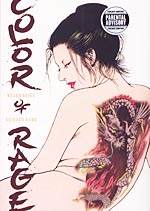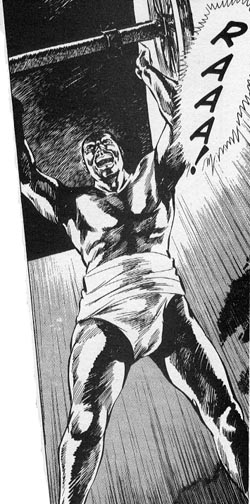 Written by Kazuo Koike
Written by Kazuo Koike
Art by Seisaku Kano
416 pages, black and white
Published by Dark Horse
Kazuo Koike is probably best known in North America for Lone Wolf and Cub, his 28-volume epic that was one of the early comics translated from Japanese to English, and which was finally reprinted and completed in translation in 2003. The problem is, while Koike and Goseki Kojima’s collaboration was great—as well as other works from the duo like Path of the Assassin and Samurai Executioner—there are an awful lot of other works written by Koike that just don’t measure up. And to that list, I’m afraid I have to add Color of Rage.
In 1782 Japan, two men survived a sinking whaling ship: “George”, a Japanese man, and King, an African-American man. Both slaves on the ship, this unlikely duo struggle not only to survive, but build a place in the world where they can live in peace. Unfortunately, peace is a long time coming for either of them.
 When I started reading Color of Rage, the basic concept seemed strong enough—two escaped slaves on the run, looking for peace even as the world around them says otherwise. Unfortunately, the more I read, the less impressed I was. Color of Rage, collecting what appears to have been intended for two volumes initially, very quickly devolves in its first half into what I can only describe as, “Fear and wonder at the big black man.” I wish I was being facetious here, but that’s unfortunately not the case. In the first two chapters, King learns he has to wrap his face in bandages as to not scare the local Japanese to death. All right, fair enough, Edo-era Japan was isolationist and our characters aren’t in an urban setting. But by the third chapter, we have King being forced to strip and lift carts for a woman’s amusement, and in the fourth chapter King starts going crazy because he’s horny and needs a woman.
When I started reading Color of Rage, the basic concept seemed strong enough—two escaped slaves on the run, looking for peace even as the world around them says otherwise. Unfortunately, the more I read, the less impressed I was. Color of Rage, collecting what appears to have been intended for two volumes initially, very quickly devolves in its first half into what I can only describe as, “Fear and wonder at the big black man.” I wish I was being facetious here, but that’s unfortunately not the case. In the first two chapters, King learns he has to wrap his face in bandages as to not scare the local Japanese to death. All right, fair enough, Edo-era Japan was isolationist and our characters aren’t in an urban setting. But by the third chapter, we have King being forced to strip and lift carts for a woman’s amusement, and in the fourth chapter King starts going crazy because he’s horny and needs a woman.
No, really. It was at that point that, dumbfounded, I flipped to the indicia to see when Color of Rage was first published in Japan. Surely it was written in a much earlier time, I decided. Maybe the ’50s or ’60s? As it turned out, the answer was 2004. I’m not saying that if Color of Rage was written 50 years ago that everything would be automatically all right, but at least it would have been slightly more comprehensible. Instead, I just shook my head through the rest of the madness. What makes up the second half of the book isn’t quite as mind-boggling when it comes to race, instead focusing on the characters being framed for murder and having to go on the run when King burns down the town of his accusers by way of revenge. The story ends without any real conclusion—perhaps it was cancelled in Japan, as there’s no indication here that there’s another volume to come—but I found myself unable to really care. There’s nothing to make me interested in these characters or their story, other than perhaps to see what cultural gaffes are in store next from Koike. And if that’s all you’re reading for, well, why waste your time?
Seisaku Kano’s art is all right; he seems better suited towards drawings of town and countryside than an actual comic that stars people. His people aren’t bad, but they do come across as more than a bit stiff and flat. He uses a lot of crosshatching and shading in his art as well, which I think is supposed to give it depth, but instead it just looks obscured and muddled. I was a little surprised to see in Kano’s bio that he is best known as a pin-up artist, but perhaps the lack of motion needed in those drawings—because that’s probably his biggest weakness—serves him well when all of your drawings are stationary.
Color of Rage is, ultimately, a huge disappointment. There’s a bonus story in the back (“Crybaby Ishimatsu”) that I felt sorry for by being included in this collection, although it’s ultimately unremarkable. This book is hardly a career high for anyone involved, save for book designer Tony Ong who did a nice job of presenting what is otherwise a disaster. From now on, if Koike’s story isn’t drawn by Kojima, I think I’m staying away until I hear otherwise.
Purchase Links:
